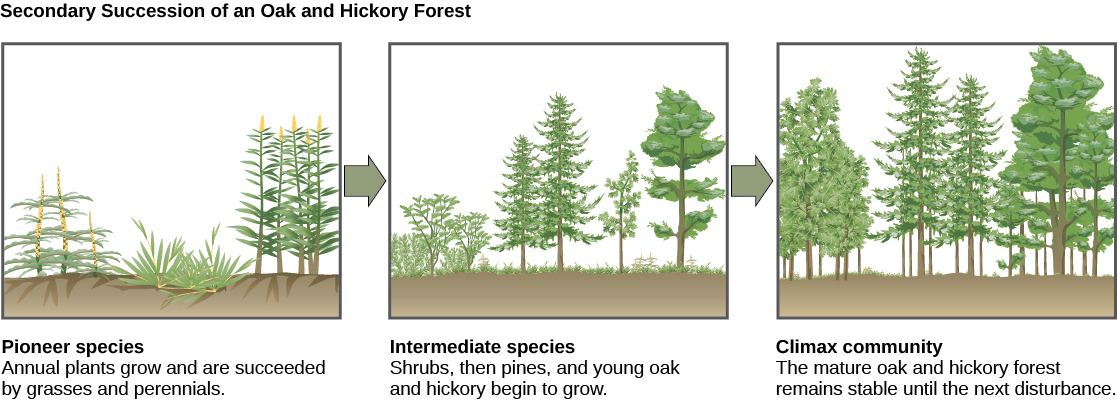| << Chapter < Page | Chapter >> Page > |
Before the fire, the vegetation was dominated by tall trees with access to the major plant energy resource: sunlight. Their height gave them access to sunlight while also shading the ground and other low-lying species. After the fire, though, these trees are no longer dominant. Thus, the first plants to grow back are usually annual plants followed within a few years by quickly growing and spreading grasses and other pioneer species. Due to, at least in part, changes in the environment brought on by the growth of the grasses and other species, over many years, shrubs will emerge along with small pine, oak, and hickory trees. These organisms are called intermediate species. Eventually, over 150 years, the forest will reach its equilibrium point where species composition is no longer changing and resembles the community before the fire. This equilibrium state is referred to as the climax community , which will remain stable until the next disturbance.

Secondary succession usually follows a disturbance of an existing community that removes or damages the vegetation, but does not remove, destroy, or cover the soil. Pioneer species in this type of successional event are likely to be plant species that have roots or seeds that survived the disturbance. This means that, typically speaking, unlike primary succession events, communities that come out of a secondary succession are most likely going to be the community that was in place before the disturbance.
The time progression of each type of successional event is really variable depending upon the circumstances surrounding the disturbance, but for the most part, primary succession takes much, much longer than secondary succession. This is because there is a lot that needs to happen after a primary event to make the habitat suitable for habitation by a wide variety of species. In most cases, even soil needs to be replenished before any more than lichen can grow there. The process of soil development happens by two processes. Firstly, the pioneer species that grow, reproduce and die quickly are a major contributor to soil production, both in terms of breaking down rock ans sediment, but also through decomposition after death. Secondly, the carcasses of organisms, such as insects and spiders, get blown in by the wind, but quickly die from lack of food will also contribute to soil buildup. For secondary events, the time frame is really no more than it takes for the organism that lived there before to move back in and reestablish themselves.
Succession events can really be measured in terms of how stable a community is. And stability, in turn, is a measurement of biodiversity and species richness. The intermediate disturbance hypothesis is the idea that there are three aspects that influence the stability of a community in relation to disturbances that alter the landscape. How intense the disturbance, how often they occur and the amount of time that has passed since the last. For all three aspects, a community is considered to be most stable when all of these aspects are not at either extreme. In other words, Species richness greatest between disturbances of moderate intensity and frequency. An example of a community that benefits from secondary disturbances would be a redwood forest in northern California. Certain species of redwood trees, such as the giant sequoia, actually require the intense heat of a forest fire to activate seeds and trigger germination events.
Communities include all the different species living in a given area. The variety of these species is called species richness. Many organisms have developed defenses against predation and herbivory, including mechanical defenses, warning coloration, and mimicry, as a result of evolution and the interaction with other members of the community. Two species cannot exist in the same habitat competing directly for the same resources. Species may form symbiotic relationships such as commensalism or mutualism. Community structure is described by its foundation and keystone species. Communities respond to environmental disturbances by succession (the predictable appearance of different types of plant species) until a stable community structure is established.

Notification Switch
Would you like to follow the 'Bi 101 for lbcc ilearn campus' conversation and receive update notifications?